Holding Big Power
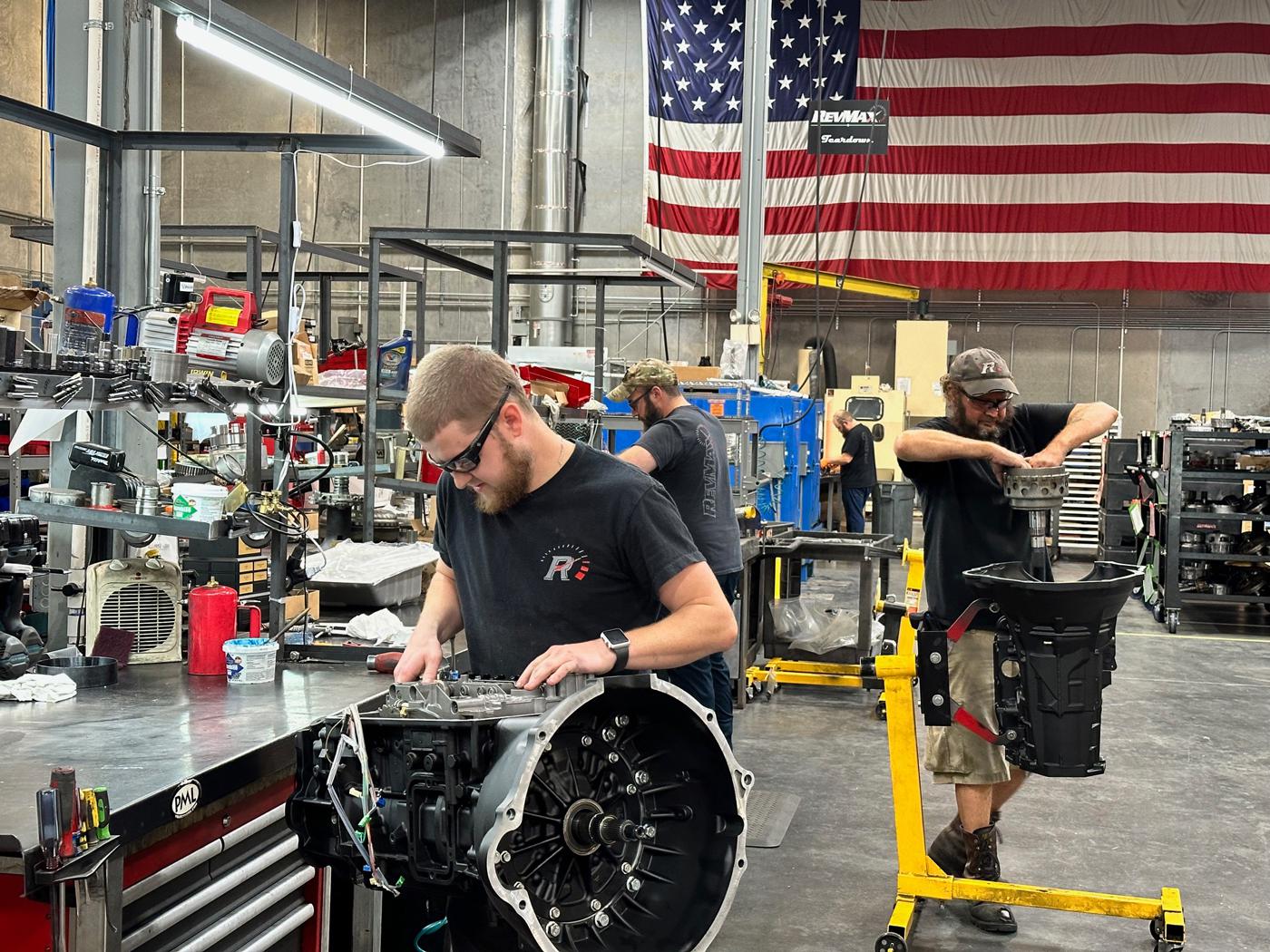
What does it take to build a transmission that’ll stand up to the punishment of diesel drag racing? Five experts weigh in.
Any transmission built for racing must handle high torque loads and change gears faster than in an OEM application. A transmission built for diesel drag racing is subjected to forces altogether higher than anything else on the drag strip.
“In any race application the transmission is going through a lot of abuse,” said Tom Hauser of RevMax, Charlotte, North Carolina (which is under the Race Winning Brands umbrella). “With diesel trucks, you have two added features. Number one is the weight of these trucks. You’re talking 6,500 to 8,000 pounds. Heck, the AS69 truck that we brought to the Ultimate Callout Challenge a few years ago was 8,240 pounds.
“Number two is the torque these diesels produce,” Hauser added. “The amount of torque on one of our UCC trucks was over 2,300 lb.-ft. And that’s small potatoes compared to some of the guys out there nowadays who are putting down 3,000 horsepower, and the torque is pushing toward that 4,000 number.”
“It’s the way a diesel makes power versus a gas car,” explained Will Terry of Power Driven Diesel, Cedar City, Utah. “When you’re making about 500 hp in a diesel, you’re usually making double that in torque. You’re making 1,000 lb.-ft., and that’s at the tire. The torque at the input shaft might be 1,200 lb.-ft.”
“At some point, some of the diesel guys went to the more common transmissions that the gas guys always run with good success, and the diesel guys would just destroy them,” observed Nathannial DeLong of Rudy’s Performance Parts, Burlington, North Carolina. “Break shafts, burn up the clutches. The diesels make so much torque that it just blows right through the converter.”
“When diesels create so much horsepower and torque, something has to become a fuse,” said Eric Sempson of Pacific Performance Engineering (PPE), Montclair, California. “Usually, the input shaft is the first thing to break, and that happens right around 1,000 hp. We always design around those intentional weaknesses.”
“The torque is what eats things up,” said Carl Rossler of Rossler Transmissions, Girard, Ohio. To withstand those high twisting forces, “everything” in Rossler’s diesel racing transmissions “is bigger, stronger, and designed to take that punishment. It’s like putting them on steroids.”
Each of these five specialists occupies a different niche in the diesel transmission market. Read on for an inside look at what they do to make their racing transmissions as bulletproof as possible.
Shift Faster and Take More Torque
PPE specializes in modifying the Allison 1000 transmissions that were OE in the Chevrolet and GMC 3/4- and 1-ton HD pickups, specifically the five-speed version used from 2001–2005 and the 2006–2019 six-speed. The company produces upgrade kits in Stage4, Stage5, and Stage6 configurations, as well as complete transmissions.
“We upgrade them to help them shift faster and take more torque and more horsepower,” Sempson explained. In stock form the Allison is “good for up to 300–400 hp, but when you start going above that there is not enough clutch surface area in the clutch packs. We upgrade the frictions and steels for the C1, C2, C3, and C4 clutch packs. We also upgrade the number of components. In some cases, there are only three or four plates. We will upgrade those to five or six plates to get more surface area, which gives the clutch surface area more holding power.” Each of PPE’s different kit stages “gets a different friction material.”
Valve body upgrades and some pump modifications provide “additional holding power for the clutch packs,” he said. They “raise the main line pressure, which gives the transmission the ability to grab the clutch stacks tighter.”
Allisons made from 2011–2019 have an electronic pressure control (EPC) valve on the valve body designed to open “to reduce drag on the transmission’s oil pump to lower the mainline pressure and improve fuel economy,” Sempson said. “But at the same time the EPC valve lowers the clutch holding capacity.” PPE offers an EPC blocker that installs between the EPC valve and the valve body that “basically eliminates the pressure drop. The computer will still open the valve and try to drop the pressure, but this little blocker part doesn’t let the pressure leak out.”
When diesel engines are “transitioning from, say, 700 to 1,000 hp, that’s when they start needing parts like a billet input, intermediate, and output shaft,” Sempson continued. The input shaft is particularly vulnerable—the “fuse” mentioned earlier—because it’s the part “that connects the torque converter to the C1/C2 drum,” he explained. “It actually has a little relief machined into it, where the diameter gets thinner and narrower. That’s where it’s intended to break.” The aftermarket shafts PPE uses “are the same size all the way through and made of a better material.”
PPE offers an upgraded torque converter with a billet, rather than cast, stator “that’s so much stronger it can handle anything thrown at it torque- and horsepower-wise.” A triple-surface clutch in the converter provides more surface area to prevent slippage when the converter locks up.
PPE also designed its own transmission pans that are made from cast aluminum with built-in cooling fins. Pans are available in a standard depth, or a deeper pan adds an extra gallon of fluid capacity.
Learn to Build
“Most racing diesel transmissions are based on a Dodge 48RE platform, which is essentially an overdrive 727,” said Terry, and Power Driven Diesel offers several transmissions based on the 48RE to accommodate a range of power levels.
Regarding the shaft upgrades mentioned in the introduction, Power Driven Diesel has several different types to choose from, depending on the engine’s output. Upgraded 23-spline input shafts are available in a variety of materials, including 300M and 300 Maraging, “which is a better heat-treated 300M,” Terry said, though at power levels from 1,500–2,000 lb.-ft., “all of them will break and twist off splines.” The next size up is a 27-spline Magnum shaft “which seems to be good up to around 2,000 hp.” The newest entry is a 35-spline input shaft from Sonnax. “To get this big shaft in there, the pump stator is bored out. They’re right on the limits of what they can actually fit in the torque converter.”
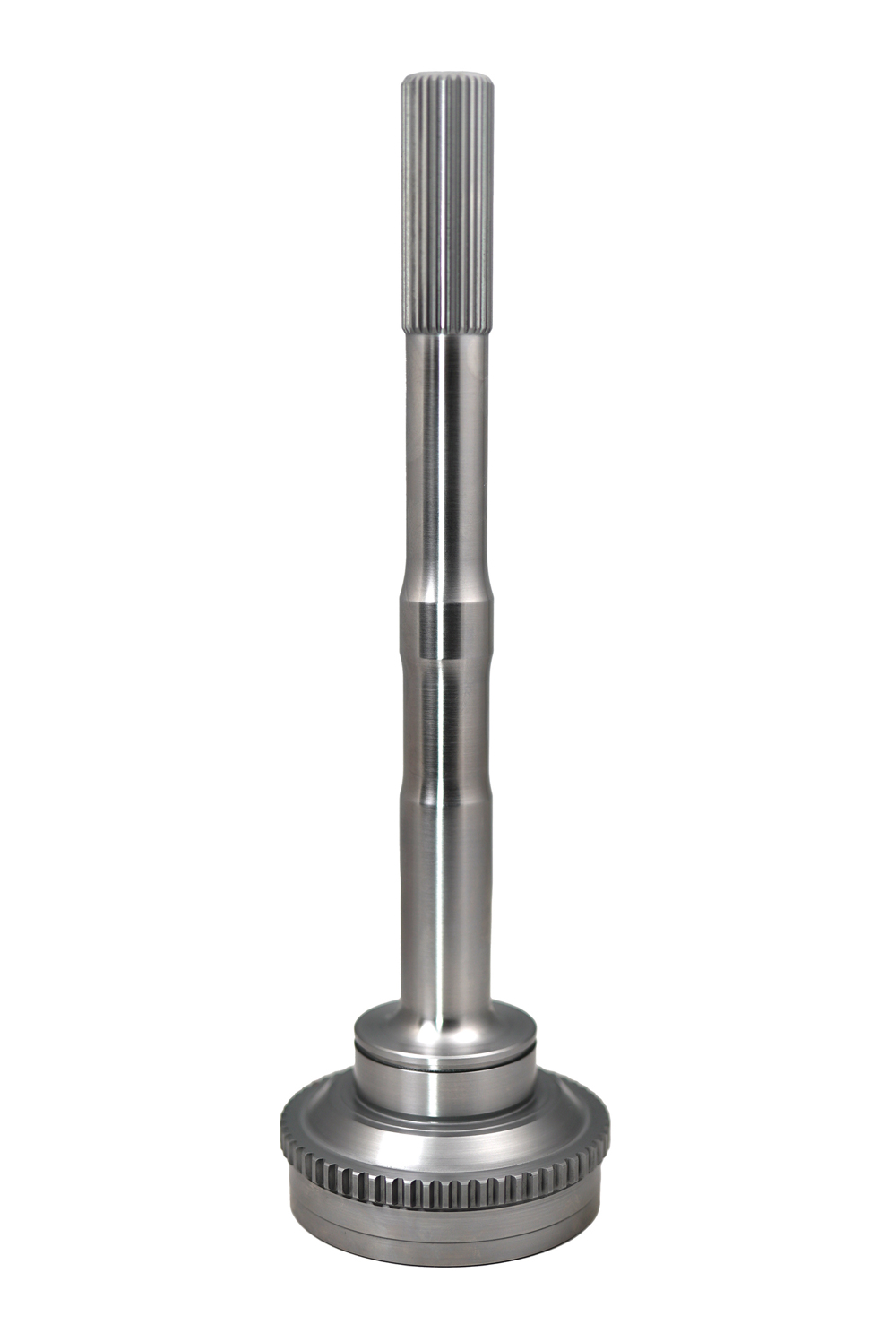
Intermediate and output shafts are also upgraded depending on power level. The threshold for the intermediate shaft is 1,000 hp “or around 2,000 lb.-ft.,” Terry reported, while the output shaft is usually upgraded at 600 hp or 1,200 lb.-ft.
There’s one more modification Power Driven Diesel makes to the intermediate shaft, Terry said. “That shaft runs through the main case and goes through this little support that has oil there. We found when we get around 1,000 hp, that case twists so much it loads that intermediate shaft, and it’ll friction weld if there’s not enough lubrication there. So we’re adding lube there, as well as in places that I’ve never seen in a gas performance transmission. We’re drilling holes and feeding oil in places that no one in our industry is doing.”
Next on Power Driven Diesel’s priority list are the clutch packs. Compared to a stock, 200-hp transmission with four clutches or a factory 48RE with five, Power Driven Diesel uses “six or seven clutches in third gear,” Terry said. As for clutch material, “if I’m holding big power, we like the GPZ clutch. We will also sand the discs with 36-grit to make the steels more aggressive.”
Power Driven Diesel matches the upgraded clutch packs with increased line pressure. “A stock 48RE makes about 140 psi,” Terry pointed out. “When we’re up there at around 2,500 lb.-ft. of torque, we need about 230 psi of line pressure to keep the trans from slipping.” Getting there requires “upgrading the valve body and the control strategy. The valve body is a huge part of it because it is a brain that controls the shift timing, the pressure, and how efficiently it makes the pressure.” To design the company’s valve body modifications, Terry invested $20,000 in a valve body test stand and another $5,000 in modifications “so our test stand will read up to 300 psi.”
In addition to its built transmissions, Power Driven Diesel offers DIY rebuild kits for those who want to tackle the job themselves.
“I strongly encourage people, if they’re racing regularly, to buy a kit and learn how to build the transmission,” Terry said. “If you want to be successful racing, you need to be able to service and build your own transmission. Sometimes crap happens, and a lot of people don’t have an extra $15,000 for a spare transmission. This is their hobby, not their job. So I highly encourage kits so people can learn.”
More Holding Power and Less Slippage
Unlike companies that specialize in one transmission brand, RevMax offers upgrades for transmissions used in Dodge/Ram, Ford, and GM diesel pickups. In many cases, those upgrades are similar regardless of the make, but all are different and tailored to that specific transmission.
“All the torque these diesel trucks produce, combined with all that weight, it equals so much ripping force where the truck is trying to rip the clutches apart,” Hauser said. “We add clutch material as much as possible. In one of our transmissions, the 12XR that goes into our 68RFE platform—which is for 2007.5–2024 Dodges and Rams—we house 20 overdrive clutches in it. The amount of material, compared to the factory, is almost double. So we have added clutch material, and more aggressive clutch material.
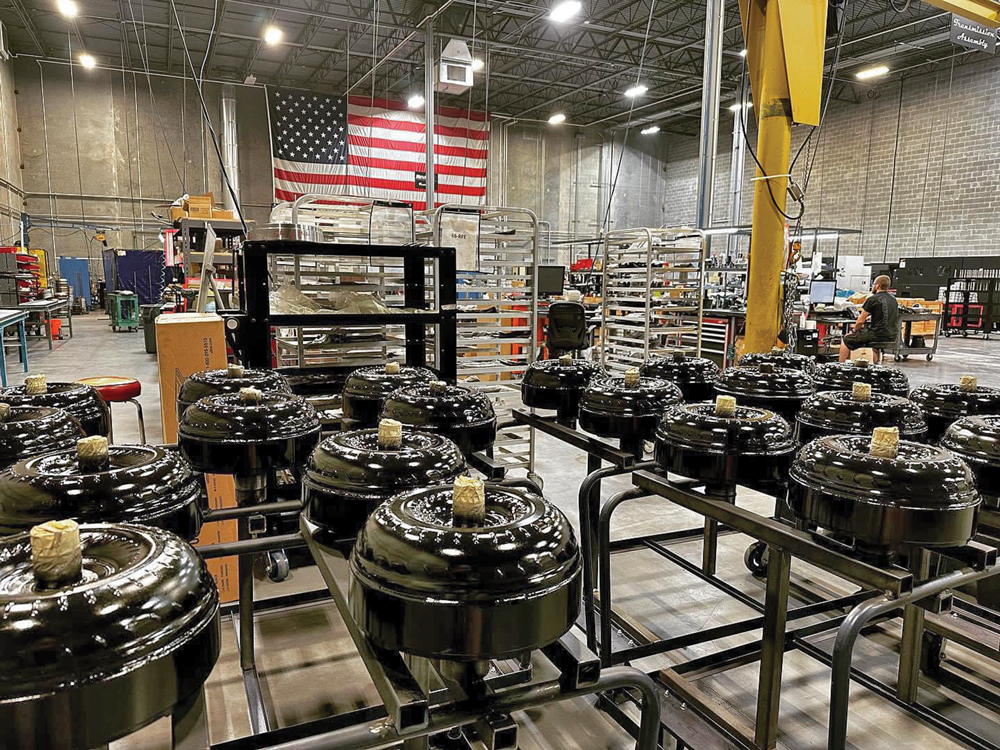
“That’s part of the equation. Then you have tuning and added line pressure,” he continued. “With some of the ‘old school’ transmissions—like a [Ford] 4R100 or [Dodge] 47RH—they’re a mechanical style where rpm goes up, load goes up, line pressure goes up, and with more clutches, that gives you more holding power. The newer trucks are all computer controlled, so that’s all done by tuning. Good tuning will increase the line pressure, and with higher line pressure and more clutches, you’ll have more holding power and less slippage.”
At that point, though, “you start to find other weak links, like input shafts or drums.” RevMax offers billet input, intermediate, and output shafts, Hauser said, as well as billet drums, like the billet overdrive/underdrive drum for the 68RFE. “We also make them out of steel, because with all that holding power on those clutches, the clutch teeth can dig into an aluminum drum, but they won’t dig into a steel drum and damage it.”
RevMax also “modifies a lot of components on the valve bodies,” Hauser said. “When we build our valve bodies, we machine the valve bores, so they are like new, and sometimes we put a billet aluminum sleeve in it so it’s not as porous as the OE cast aluminum bore. We’ll also put in a better valve or a steel valve, so it doesn’t wear like the factory one.” RevMax also installs “billet accumulators, and then we put in heavier duty springs. We put billet channel plates on them, which don’t flex and allow cross leaks. We also do a bonded separator plate with a very thin gasket on it that allows for even fewer leaks inside that valve body.” Hauser pointed out that “all valve bodies have controlled leaks in them, but crossed leaks over the worm tracks will cause shift flares, shift binds, and it could cause a catastrophic failure in that transmission.”
Hauser said RevMax is working to develop upgrades for newer truck transmissions, but it’s difficult. “When you open up these new 10-speeds, there’s very little you can do to them because they’re so compact, so tight. We can add clutches to the 10-speeds, but it’s only 28–35% more, not like some of the older units where you can double the clutch capacity.” That, and the electronic controls on these transmissions, are causing some racers to swap the new gearboxes for older transmissions that are hydraulically controlled. “They don’t have to worry about the computer program or programming it correctly.” Plus, “a lot of racers like to go to the older style because people have been building those transmissions for 30-plus years. They know what works and what doesn’t work.
“But mark my words, five years from now, everybody’s gonna come around and say, ‘This [10-speed] isn’t so bad, because they figured out how to make it hold the power, how to make it last a while.’ And they’ll still have all their creature comforts.”
Everything Inhouse
“Every year the diesel guys are getting better and better,” Rossler said. “They keep coming up with new ways to hold more power with the blocks and heads, and the bolts to keep the motor together.” That challenges Rossler and his 10-man team to improve their transmissions “to overcome what the diesel guys keep throwing at us.”
All of Rossler’s transmissions are based on the venerable Turbo 400 and can be mated to any diesel with the appropriate aftermarket bellhousing. What sets a Rossler transmission apart from others on the market is the fact that, other than the pans and the Reid transmission cases, “we manufacture everything inhouse so we can develop it and change it,” Rossler said. “We can have new gear ratios, new parts. We can change how we do things to take the weak links out. If we see a problem, we can re-engineer it and get it right back out.”
The Reid cases “have a little bit more room in them, which lets us build components that are a little bigger,” Rossler explained. “You can’t increase the size of one thing without increasing the dimensions of the other pieces to fit it all.”
Nearly every component in the transmission is billet, according to Rossler. “We manufacture the whole inside,” he said. “The gear sets don’t look anything like the original gear sets. The drums are much larger, and they’re lighter. We do everything in aircraft aluminum, and then it’s supported with steel inserts. They’re very lightweight, very strong, and very safe because the aircraft aluminum doesn’t explode like it would if it was a cast drum.”
Rossler noted that he’s seen “a lot of shops use steel drums, which is nice, because they are strong, but they’re sort of heavy. There’s no need to have that. You can save horsepower through the drivetrain. We can’t make horsepower, but we can save horsepower, that’s for sure.”
The torque converters Rossler supplies for diesel racers come from Neal Chance Racing Converters of Cheney, Kansas. Drag racing diesel trucks need lockup torque converters, Rossler explained, “because diesels work off torque. They have to have load to make torque.” The Neal Chance converters have a “multiple-stage lockup so the clutch comes on a little softer. It doesn’t run all the power at one time because that can break components and upset the vehicle. It comes on a little bit gradual, and the efficiency is 100% once it locks so it takes all the motor power and puts it through the drivetrain to get it to the tires. That’s way more efficient on a diesel. If you ran an open converter, it would pretty much slip going down the track.”
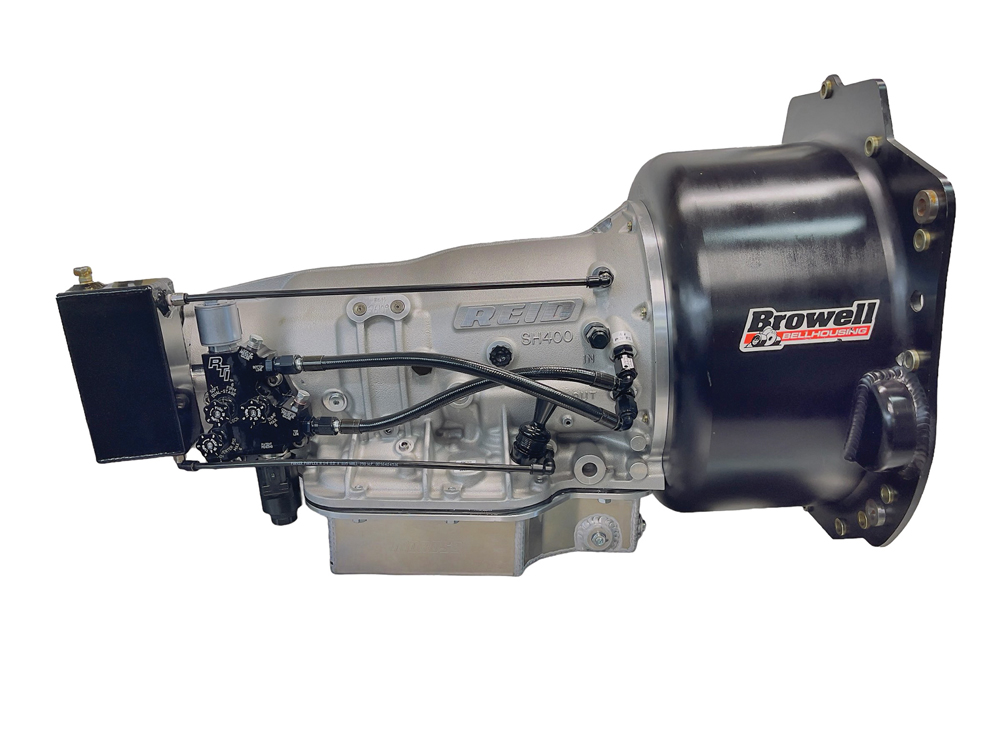
Those converters are “so large they won’t fit in a conventional bellhousing,” Rossler said. His primary bellhousing supplier, Browell Bellhousing of Lafayette, Indiana, makes “clutch-can-style bellhousings with way more room.”
Another component unique to the Rossler transmissions are the valve bodies, for which he has a patent pending. “We call it a direct-port valve body because we feed the servos and everything without the case. We do everything through the valve body. Most valve bodies direct the oil through the case, through the valve body, back to the case, around everywhere, and back to where it’s going. We take it directly to where it’s going.” Like his other components, the valve bodies are made inhouse, down to winding the coils for the solenoid. “Nobody makes what we need, so we make it ourselves,” he added.
Reliability vs. Holding Power
At Rudy’s Performance Parts, “we’ve always been Ford guys,” said DeLong. “We offer stuff for the Cummins and the Duramax, but we specialize in the Power Stroke.” The upgrades Rudy’s offers for the 2003–2007 5R110 and 2011–2019 6R140 transmissions are available in stages.
“With the stages, you fix one problem, and then there’s the next thing that will become the failure point,” he explained. “That’s how the stages progress.”
For the 5R transmissions, Rudy’s starts the upgrades with a billet input shaft. “When you have more power and a good converter, like an aftermarket triple-disc converter, it’ll break the factory input,” DeLong explained. “Then if you get a good input, you might break a low/reverse hub, or the intermediate shaft, or one of the planetaries.” The “end-all” Stage 5 upgrade for the 5R includes all billet internals—input, intermediate, and output shaft; overdrive planetary; and low/reverse hub—plus more clutch material than the lower stages.
DeLong described the 6R as “pretty stout” and said input shaft failures are rare. The top upgrade level for the 6R replaces the intermediate shaft with a billet shaft and billet apply pistons, plus aggressive clutch material.
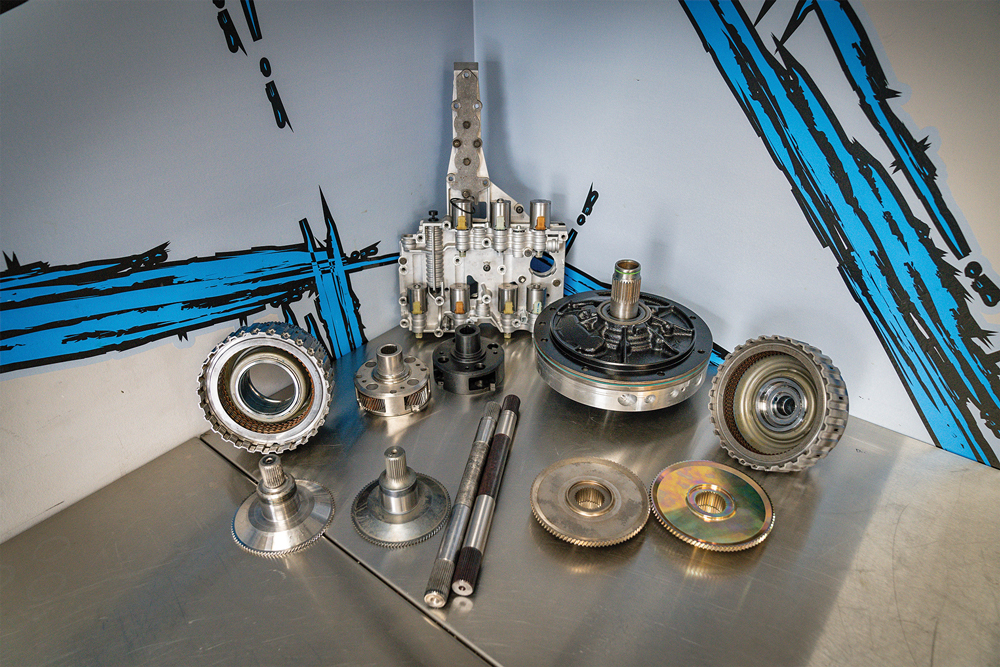
Regarding the clutches, DeLong said “additional frictions over stock counts are added in all stages. The main difference in a 6R build is which intermediate shaft is selected. It’s that balance of reliability versus holding power. If you stack too many in there, put a bunch of thin frictions and steels just to get the clutch counts way high, they might not last as long because they’re so thin they’re going to warp.” Even the racer who goes for the Stage 5 upgrade, whose “one concern is holding power, he knows going into it the clutches may not last several seasons, but they’re going to hold pretty consistently over time.”
Regardless of upgrade level, “every transmission I do is washed after disassembly, and each part is also run through our ultrasonic cleaner to ensure everything is as clean as possible before assembly,” DeLong said. “To add additional frictions, the apply pistons and pressure plates must be machined, which is all done inhouse. All the bushings throughout the transmissions are pressed out and replaced with bushings coated with Calico’s CT-1 dry film lubricant, the same coating used on engine bearings. The pump gets several internal modifications, including updated valves, one of which is the Sonnax oversized pressure regulator valve. I ream the valve bore and install this valve because the factory valve commonly sticks over time. This ensures the bore is perfectly aligned and smooth, and sticking is no longer a concern.”
DeLong said Rudy’s has offered upgrades for the 5R “forever, and I started messing with the 6Rs because it seems like we have a lot of demand for those.” Next is work on Ford’s new 10-speed transmission, “then I might start doing a little bit of Allison stuff, too. Our goal is to keep expanding, to be able to offer a little bit of everything if needed.”
SOURCES
Pacific Performance Engineering (PPE)
ppepower.com
Power Driven Diesel
powerdrivendiesel.com
RevMax
revmaxconverters.com
Rossler Transmissions
rosslertrans.com
Rudy’s Performance Parts
rudysdiesel.com
 MEMBERSHIP LOGIN
MEMBERSHIP LOGIN JOIN PRI
JOIN PRI


